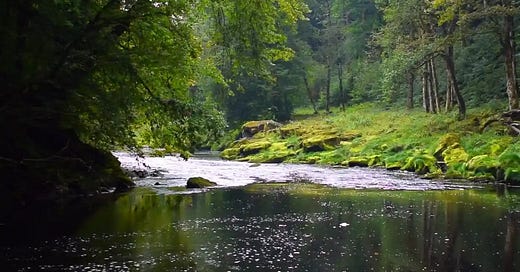In June 1967, I, together with my classmates, cowered in fear at Broadgate School, comforted by our teacher, as terror rained down from the heavens. In those days, extreme weather wasn’t so common, but this day in June 1967 was exceptional. Hailstones as large as golf balls. By the time the storm was over, barely a hailstone was to be seen, as the summer sun came out; and everything was well in the world again.
Broadgate Primary School is in Horsforth, up the road from St Mary’s Catholic denominational school. We wore green, they wore brown. There was friendly rivalry between us, but, at seven years old, I was barely conscious of it. To my chagrin, my parents would pull me from the school, owing to a poor educational experience that my elder brother had had in the top class. Instead, I was sent to St Margaret’s, where we wore blue. And that was the last I heard of Broadgate School. Until today.
Alfie Lewis was 15 years of age. His suspected attacker 14. The one is now dead and the other is in custody, and a tragedy has played out in front of the school where I once played. That is shock that hits home. Kharkiv is a place in pain, and so is Gaza City and I can feel for those places, but though I am taken aback by the stories from those places, nothing takes you aback quite like the killing of a child, for which a child’s been arrested, in front of the school I attended as a child.
Image: from The Guardian, the late Alfie Lewis. Click the pic for his story.
As a kid, nothing generated more excitement than a summer excursion to the Yorkshire Dales. I was lucky to grow up in a rural part of Leeds, reputedly the largest village in England, Horsforth, named as the ford over a brook where horses would cross. We lived up the road from Horsforth railway station, which was then painted in the white and pale blue of the North-Eastern Region of BR, and I remember to this day the lovely stink of the creosoted railway sleepers as we’d stand and wait by the old characteristic NER sloping picket fences for the trains to Harrogate, York or Leeds.
The Dales were no longer reachable by rail in my day, the line having been lifted beyond Addingham across to Otley (the formation is now the Otley by-pass) and on up to Ilkley, and the Shipley line having been truncated anyway at Ilkley. There would later be the heritage railway at Embsay, but that needed to be reached via Skipton on the main line across the Pennines, which I also took on occasion and which transported the famous Thames-Clyde Express: the stunningly beautiful Settle to Carlisle line.
Instead, we’d be bundled into our neighbours’ Singer Vogue, with its hooded headlights, or my dad’s Sherman-tank-like Wolseley 16/60, which my ma had once driven backwards down the central reservation of the A74 in an endeavour to avoid a plank of wood on the carriageway, both of which feats she succeeded in, with grandeur. And off we’d travel, seatbelt-less, up the A65 as far as Grassington, to Fountains Abbey, Burnsall and Bolton Abbey.
Later, in geography class, I’d learn the mnemonic SUNWACD, which are the rivers of Yorkshire from north to south: Swale, Ure (which flows into the Ouse), Nidd, Wharfe, Aire, Calder, Derwent. My school stood on the banks of the River Aire, a murky, filthy, industrial river skirting the north side of Bradford and driving through the middle of Leeds. It was home to leeches, some of which were kept in glass jars in the school’s senior biology lab, thus precluding rowing as a school water sport. However, these childhood pleasure trips were always to the Wharfe. In my later teens, I would row boats on the Wharfe at Otley, and as nippers we’d paddle, swim and dive with snorkels to see the myriad fish in the clean, clear waters down from the ruins at Bolton Abbey. Picnics on a rug, pop drunk from paper straws that always got too soggy. And the special treat when all was packed up and the day done at the riverside: stopping off at White Cross, Guiseley, for a rare old fish supper from Harry Ramsden’s, out of cardboard containers and wooden forks on the back seat of the Wolseley in the car park: fish and chips doesn’t belong in a restaurant, not if you’re a kid. We were always ravenous after a day at the Wharfe.
Now, a day at the Wharfe will find you covered in effluent. The fish are all but gone, the river stinks as bad as the Aire used to down at the school. We were told as kids just to do a wee-wee in the river. Now it’s far worse than that that flows with the current, pumped out as “overflow waste” from supposed purification stations. Raw sewage into the beautiful Yorkshire Dales. Paid for by the good water-consumers of West and North Yorkshire. I doubt many families pack their children up seatbelt-less onto the back seats of Wolseleys or of any car these days for a happy day of picnic and togetherness up at Bolton Abbey. The river has been left to rack and ruin by the great water corporations that we, oh, so trusted to manage our water systems for us, back in the heady days of stockholdership and deregulation. By the time I left school, the leeches in the biology lab were the only ones left, so much effort had been put into cleaning up the River Aire. I wonder how it’s faring now, after the water scrooges have been let loose on her since the dawn of deregulation in the 1980s.
Image: from The Guardian—the Wharfe at Bolton Abbey. Click the pic for their article.





